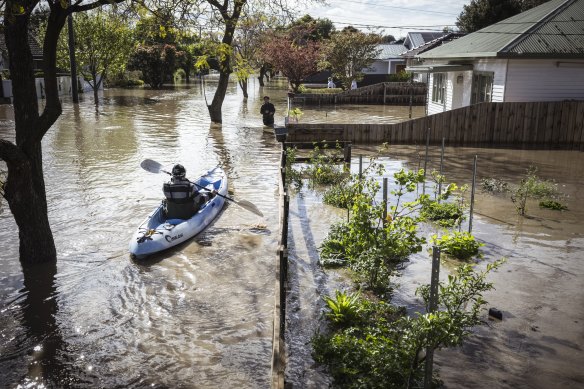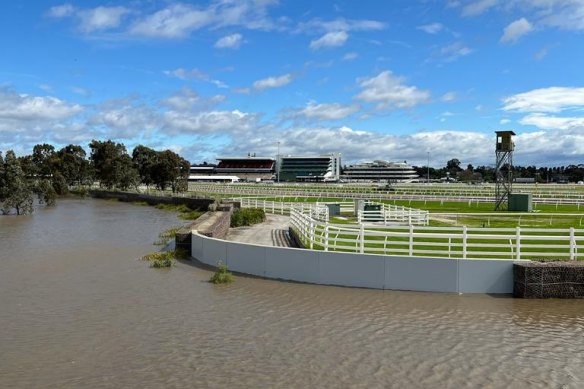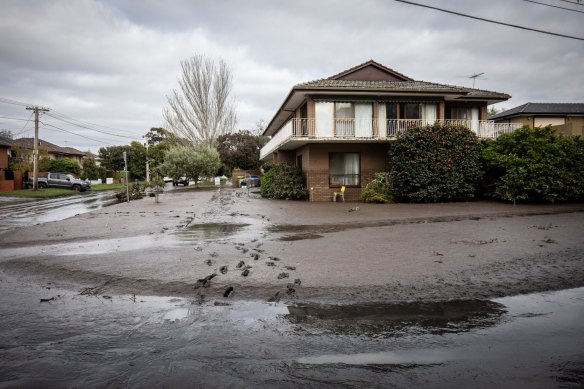By Clay Lucas and Sophie Aubrey
Melbourne Water’s inquiry into floods that devastated hundreds of homes in the city’s west last October will deliberately exclude analysis of early warning systems, urban planning and government policies that might be made in response to the event.
Residents and former senior Melbourne Water staff said the water authority’s decision to limit the scope of the Maribyrnong River flood review was a serious error and would result in crucial factors that led to the inundation being ignored.

A person paddles through a street in Maribyrnong on October 14, 2022.Credit: Chris Hopkins
Melbourne Water’s terms of reference for the flood inquiry were released on Tuesday. They specifically exclude five items: policy responses, building future flood walls or dams to reduce the Maribyrnong’s capacity, emergency responses including warnings and evacuation procedures, flood recovery, and planning matters.
“I’m wondering what they will do with their time – what on earth they are going to look at in this inquiry?” said Ron Sutherland, a civil engineer who was Melbourne Water’s manager of land development for more than a decade. He left the water authority in 2003.
Sutherland said urban planning was crucial to what unfolded along the Maribyrnong on October 14, because of the number of homes and developments now built in flood-prone areas. The inquiry though will not look at planning. “So what’s the point of the inquiry?” he said.
More than 520 properties in the Maribyrnong City Council area were directly or indirectly affected by the floods, while many homes in surrounding suburbs were also impacted by the overflowing river.
The floods were the biggest to hit Melbourne’s west since the Maribyrnong burst its banks in 1974. Those floods were regarded as a once-in-50-year event and hastened the establishment of new drainage laws in 1975 that dictated new homes across Melbourne must not flood.
There was immense public anger last year at the state government and Melbourne Water over a flood wall surrounding parts of Flemington Racecourse, approved for construction in 2007 against the wishes of three Melbourne councils and many Maribyrnong residents.
That 2.4-metre-high embankment along Flemington Racecourse’s river frontage protected it on October 14 from flooding while its neighbours across the river were inundated by the rising waters.
The flood wall will be reviewed by the Melbourne Water inquiry, according to the terms of reference.

The flood wall around Flemington Racecourse on Friday October 14.Credit: Aisha Dow
In all, the review will look at nine aspects of October’s flood, including its overall impact, what contributed to the event, and future flood modelling and prediction.
Melbourne Water managing director Nerina Di Lorenzo said the inquiry would focus precisely on what unfolded last October, noting Maribyrnong residents “have gone through a really hard time”.
“We really need to complete the work in a timely way because so many broader considerations will come from just getting a very clear picture of exactly what happened,” she said.
Di Lorenzo said if the scope of the inquiry was too large, it would take too long to complete. “It’s something that should be done in a timely way.”
She also said some of what had unfolded during October’s flood was outside Melbourne Water’s areas of responsibility. “Issues like the way the incident was managed, warnings, broader planning considerations: these involve multiple agencies. They are much broader than Melbourne Water.”
Di Lorenzo said she was aware of how traumatic the floods had been for those whose homes were hit, and the inquiry would ensure that “residents have a chance and a way to have their voices heard”.
Asked if Melbourne Water had a role in providing the emergency response to the floods, Di Lorenzo agreed it was one of several agencies providing data to the State Emergency Service to inform warnings to people of imminent floods.
The flood-warning system has been a major point of contention, with many residents unaware they were at risk of flooding on the morning of October 14 until water was already in their driveways.
Residents in Maribyrnong whose homes were inundated that Friday morning said they were disappointed by the review’s narrow focus.
Lee Lanzafame, whose Clyde Street house was flooded, said he was stunned that issues with the warning system would not be included and wanted to see attention given to potential policy responses and mitigation measures.
“I’m shocked to be honest,” Lanzafame said. “I don’t know if the Arundel Dam is the right solution, but at least let’s have a conversation about why it isn’t and what is the right thing.”
Fellow Maribyrnong resident Suzie Fakhri feared the review would fail to assure residents that action would be taken to help prevent future flooding.

The aftermath of the flooding in Maribyrnong.Credit: Scott McNaughton
“How do we fix this so we don’t have to go through this again? We’re in the 21st century and we should have the resources and infrastructure to prevent the severity of flooding,” Fakhri said. “If nothing is going to be done, I’m considering moving. I don’t feel I need to be going through this.”
Geoff Crapper, a hydrologist who has specialised in the Maribyrnong River for decades and worked at Melbourne Water from 1972 until 2003, said excluding key items from the scope of the inquiry was a poor decision.
“They’re just ticking a box with this inquiry,” he said. “They don’t want the answers to come out to what went wrong.”
A spokeswoman for acting Water Minister Lily D’Ambrosio said the review was “being undertaken by Melbourne Water and we’ll await the outcomes and recommendations”.
The Morning Edition newsletter is our guide to the day’s most important and interesting stories, analysis and insights. Sign up here.